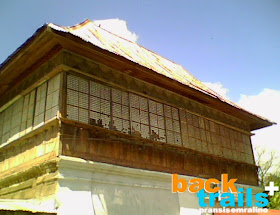 * one huge colonial house; this one once housed a clinic
* one huge colonial house; this one once housed a clinic * the house’s side roof, gate, and door
* the house’s side roof, gate, and door* another look at the house; this place (it seems to me) is characterized by a rural feel
 * a simple wooden house; found just beside the town plaza
* a simple wooden house; found just beside the town plazaOne must pass through a number of rivers and streams and hilly terrains to reach the town of Ibaan in Batangas. This observation is true if you are coming from the town of Rosario or from Batangas City. This semi-seclusion gives the town a predominantly rural atmosphere despite having a number of establishments in the town proper.
 * the church’s door and handle
* the church’s door and handle * Señor Santiago Street where the Ibaan Municipal Library (Miguel Mercado Memorial Library) and some old houses are found
* Señor Santiago Street where the Ibaan Municipal Library (Miguel Mercado Memorial Library) and some old houses are foundThe streets in town are still narrow, a feature that can be traced back to the Spanish administration of such towns. Finding a bahay-na-bato is a prize already, seeing that most of it are non-existent in the town proper. As for Ibaan’s industry, online reading would tell us that the townsfolk are (or were?) adept in making kulambo or mosquito nets. However, I did not notice any stores which sell such products. The town also has its own political problems which I do not want to discuss here.
 * an engraving of the face of Don Lorenzo Ilustre
* an engraving of the face of Don Lorenzo Ilustre * I got curious of this tank found behind the Ibaan Central School and so I decided to take a photo of it
* I got curious of this tank found behind the Ibaan Central School and so I decided to take a photo of itMore than the mosquito nets, Ibaan would most likely be remembered by one of its illustrious sons: Don Lorenzo S. Ilustre. Don Lorenzo (born on August 8, 1866 in Ibaan) was a noted musical composer and conductor, having set danzas, kundimans, and instrumental melodies. He was later drafted as a military man both during the Philippine Revolution and Filipino-American War. After his war years, he opened a store in Batnagas which he named Ang Kaibigan. (It would be interesting, I think, to dig in about his reasons for using that name.) An online biography of his can be read here.
Aside from the remaining colonial houses, the town church is also another interesting find in Ibaan which will be the topic of my coming entry.
[How to go to Ibaan, Batangas: 1) From Manila, one can just board a bus bound for Lucena (buses can found along EDSA Cubao or at Gil Puyat LRT Station) and drop off at Sambat ng Candelaria (in Quezon). From there, wait until a Supreme Bus arrives bound for Batangas City. Board the bus and tell the conductor to drop you off at Ibaan. 2) Alternatively, you can start from Lipa City. Ride a jeepney bound for San Juan, Batangas and drop off at Rosario town proper. From there, wait for another jeepney, this time bound for either Batangas City or Ibaan, and board it. As of this writing, jeepney fare from Rosario town proper to Ibaan is 15 pesos.]




No comments:
Post a Comment